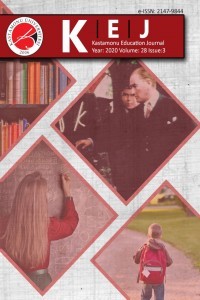Visual Appearance Features of Sign Language Avatars
Visual Appearance Features of Sign Language Avatars
Purpose: 3D Sign language avatars communicate with individuals in digital environments, like educational agents. However, while designing educational agents, the target group comes to the fore. In the literature, it is seen that the visual appearance features that should be considered in the creation of avatar designs are specified in diverse ways. Main goal of this study is to evaluate the sign language avatars’ visual appearance features in the literature and applications within the framework of educational agents.
Design/Methodology/Approach: In this study, seventy-nine different sign language avatars’ images were evaluated within the framework of visual appearance features. Seven category and fifteen features were evaluated by four field experts through focus group discussions.
Findings: In the evaluation, seven important categories were determined in avatar visual appearance. It is seen that the eye and head designs of avatars are generally designed in normal size. If an iconic design process is being carried out, eye, head, arm, and finger visual appearances should be designed larger than normal. If a realistic design process is carried out, eye, head, finger, palm, and arm visual appearances should be designed in normal sizes.
Highlights: When designing sign language avatars, the upper body should be visible. In addition, what the target group will be affects the gender and iconicity of the avatar. Avatar should be designed simply so that individuals do not overload their visual channel. Also, different visual appearance features should be considered for iconic or realistic avatars. In addition to this, it is recommended that the hand and head sizes should be bigger than normal in order to understand the signs and non-manual signs more clearly.
Keywords:
3D avatar design, Sign language, Educational agents,
___
- Adalı, H. A. (2019). Öğretmen adaylarının türk işaret diline ve dersine yönelik görüşleri [Master’s thesis]. Trakya Universty.
- Adamo-Villani, N., Doublestein, J., & Martin, Z. (2004). The mathSigner: An interactive learning tool for american sign language K-3 mathematics. Proceedings of the International Conference on Information Visualization, 8(1), 713–716. https://doi.org/10.1109/iv.2004.1320220
- Adamo-Villani, N., Lestina, J., & Anasingaraju, S. (2016). Does Character’s Visual Style Affect Viewer’s Perception of Signing Avatars? In Lecture Notes of the Institute for Computer Sciences, Social-Informatics and Telecommunications Engineering, LNICST (Vol. 160, Issue September, pp. 1–8). https://doi.org/10.1007/978-3-319-28883-3_1
- Yayın Aralığı: Yılda 4 Sayı
- Başlangıç: 1995
- Yayıncı: Kastamonu Üniversitesi
Sayıdaki Diğer Makaleler
How Well Do International Students Adapt to The Turkish Higher Education System?
Dilek İLHAN BEYAZTAŞ, Yakup BOSTANCI
Foreign Language Teaching Anxiety of Turkish EFL Teachers
Yasemin Cansel İSKENDER, Merve SAVAŞÇI
Visual Appearance Features of Sign Language Avatars
Murat ATASOY, Lokman ŞILBIR, Semra FİŞ ERÜMİT, Ekrem BAHÇEKAPILI, Adil YILDIZ, Hasan KARAL
Curriculum Implementation Approaches of Secondary School English Teachers: A Case Study
Gülçin ÇELİKER ERCAN, Zühal ÇUBUKÇU
Ali KAYMAK, Hasan Fersat TAŞLIBEYAZ, Metehan KUTLU, Erkan ARI
